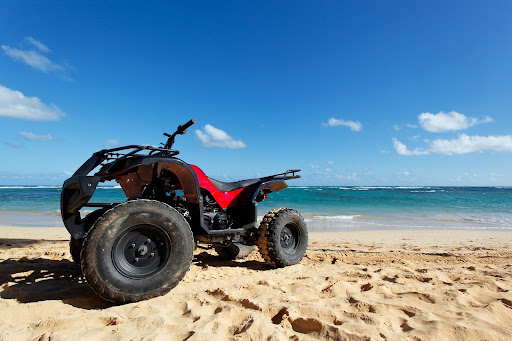Riding your Polaris ATV offers unmatched excitement- from the engine’s roar to the joy of climbing and the freedom of open trails. But before you unleash your inner dirt warrior, make sure you are prepared.
Here’s a comprehensive guide to making sure your Polaris ATV is ready for whatever terrain you throw at it.

Contents
Safety First: A Pre-Ride Inspection
Safety should always be your priority. Expert off-roaders recommend a thorough pre-ride inspection. This includes the following:
- Fluids: Check the engine’s oil, coolant, and brake fluid levels. Specific capacities and recommended types can be found in your owner’s manual.
- Tires: Check for wear and tear and ensure proper inflation for the terrain you will be conquering. Lower pressure may be appropriate for dunes, whereas rocky trails require higher PSI.
- Brakes: Make sure that you check responsiveness and leaks.
- Lights: Ensure all headlights, taillights, and turn signals are working properly for maximum visibility.
- Nuts and bolts: Inspect everything thoroughly for any loose components. Tighten them according to the manufacturer’s instructions that come with the vehicle.
- Air Filter: A clean air filter improves engine performance. Replace it, if necessary, using the instructions in your manual.
Gear Up: Essential Parts and Accessories
Now that your ATV is in top condition, let us prepare it for the adventure. Here are some important components and accessories to consider:
- Winch: It is possible to become stuck off-road. A winch can be a lifesaver, allowing you to recover yourself or assist other riders.
- Skid plate: Protecting your ATV’s undercarriage from rocks and other obstacles is critical. A skid plate is a valuable investment.
- Helmet: A no-brainer for safety. Select a DOT-approved helmet that fits comfortably.
- Goggles or glasses: Eye protection keeps you safe from dust, debris, and branches. Consider options with anti-fogging capabilities.
- Gloves: Wearing proper riding gloves will protect your hands from blisters and help you grip the handlebars securely.
- Spare tire and tools: A flat tire can ruin your adventure. Carrying a spare and basic tools allows for a quick fix and helps you get back on track.
Finding the Perfect Parts: OEM vs. Aftermarket
When it comes to repairing Polaris ATV parts, there are two main categories: OEM (original equipment manufacturer) and aftermarket.
OEM parts are manufactured to your Polaris model’s exact specifications, ensuring a perfect fit. They may cost slightly more, but the assurance of quality and compatibility is priceless. You can find Polaris OEM parts on the Polaris website, from local dealers, and from reputable online retailers.
On the other hand, aftermarket parts provide a more diverse range of options at potentially lower costs. However, poorly chosen aftermarket parts can degrade performance and even damage your vehicle.
Here are some tips for selecting Polaris ATV parts:
- Consult the owner’s manual: It often includes part numbers for specific components, making it easier to find the relevant fit.
- Search the Polaris website: The Polaris website has a user-friendly catalog in which you can enter your model number and search for specific components.
- Visit your local Polaris dealer: Dealers have access to a large parts inventory and staff who can help you find the exact parts you require.
Frequently Asked Questions
1. Where can I find Polaris OEM parts?
You can use the Polaris website’s parts catalog and consult dealers for assistance. You can also search online with trusted sellers to find authentic and compatible OEM parts.
2. What’s the difference between OEM and aftermarket parts for my Polaris ATV?
OEM parts are built to your Polaris model’s unique specifications. They ensure optimal fit and performance but are slightly higher-cost. Aftermarket parts provide more options at a lower cost. However, they may lack the same quality and compatibility, potentially jeopardizing your ATV’s performance.
3. How long does the (break-in period) initial use period last for Polaris ATVs?
For youth ATVs, ACE 150, and RZR 170 models, the break-in phase lasts 10 hours. It may also last until two tanks of gasoline are used. For the RANGER 150, this extends to 20 hours of use or the consumption of two full tanks of gas. This period is crucial for ensuring the vehicle’s optimal performance.
4. Why are Polaris parts difficult to obtain?
Polaris attributes the challenge in acquiring parts to the robust market demand for its off-road vehicles, snowmobiles, and motorcycles. However, global supply chain disruptions have constrained the production of new vehicles. This has resulted in product scarcities at dealerships and a reduction in sales across North America.
The Final Touch: Customization and Comfort
With the basics covered, think about customizing your ATV for more comfort and functionality. According to Polaris Parts Nation, riders must get a range of accessories to enhance their off-road experience. Here are a few popular choices:
- Storage solutions: Cargo racks, saddlebags, and storage compartments hold essential equipment, tools, and supplies.
- Winch mount and fairlead: A proper winch mount ensures a secure installation, while a fairlead gently guides the winch cable.
- Handlebar grips: Upgrade your handlebar grips for more comfort and control, especially on long rides.
- Hand guards: Sturdy handguards will protect your hands from brush and debris.
- Lift kit: For more difficult terrain, a lift kit increases ground clearance, allowing you to easily navigate obstacles.
Polaris offers performance parts such as exhaust systems and shock absorbers. These parts help experienced riders fine-tune their ATVs’ capabilities.
Remember, while embracing the essence of adventure, preparing your Polaris ATV is the first step towards unforgettable off-road escapades. Happy trails. May your adventures be as boundless as the journey you explore.